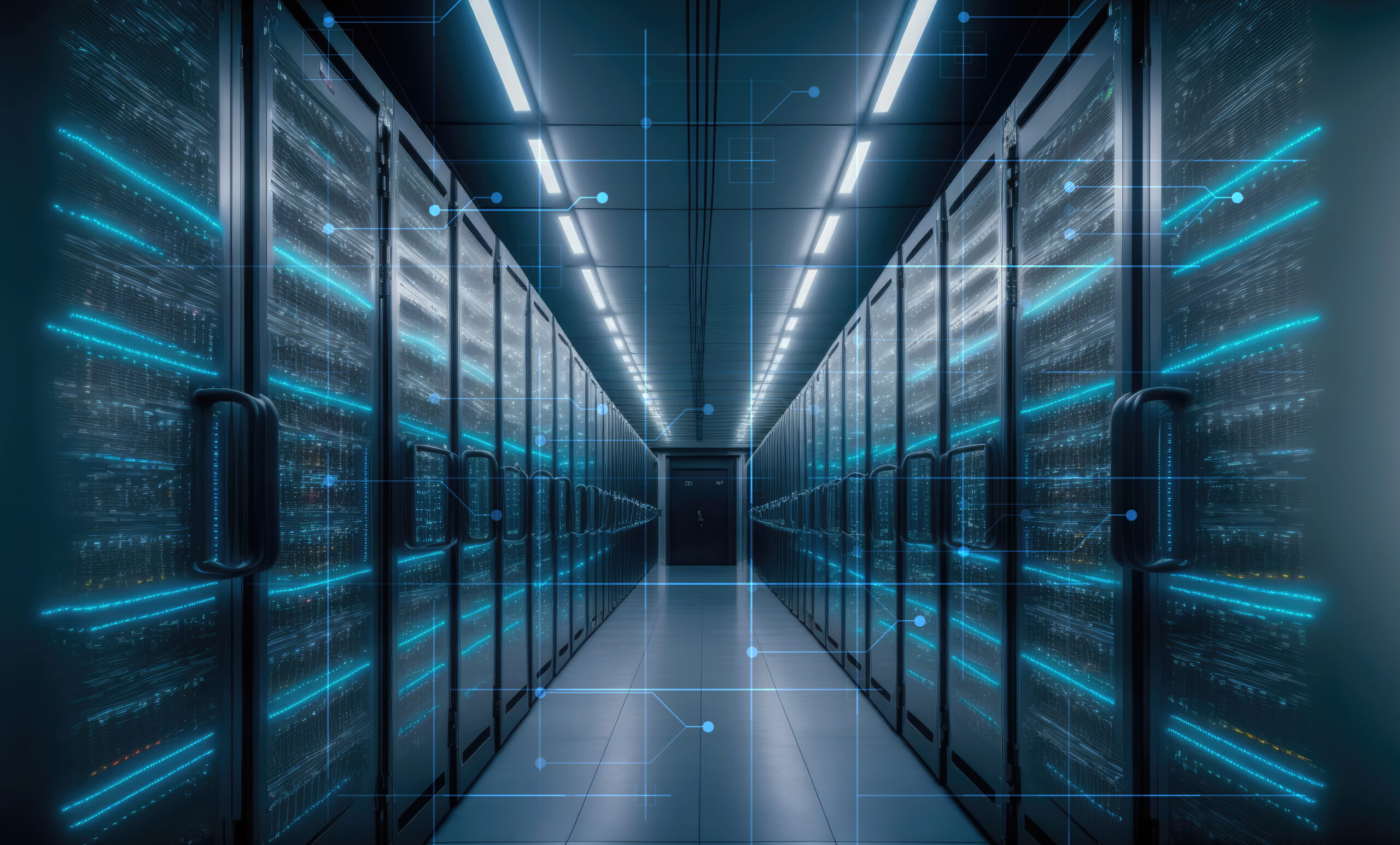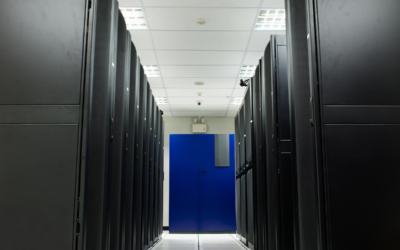The Economic Impact of AI And the Role Data Centers Will Play in Achieving It19 min read

AI is shaking things up in all sorts of areas. Including the data center. At the UiPath conference in October, AI was very much front and center.
David Barber, Director of the University College London’s Centre for Artificial Intelligence, laid out just how much progress had been made over the past decade in AI achieving the same level of performance as humans or better. He listed the dates when AI caught up with humans and has since surpassed them:
- 2013 for handwriting recognition.
- 2015 for speech recognition.
- 2016 for image recognition.
- 2017 for reading comprehension.
- 2019 for language understanding.
- 2022 for common sense completion of tasks.
“AI is not quite there yet for grade school math and code generation but it is getting closer,” said Barber.
No wonder AI has suddenly come of age. It is everywhere. It is shaking the economic foundations in a way that will inevitably change the data center.
Fire, The Wheel, AI
Erik Brynjolfsson, Director, Stanford Digital Economy Lab and Senior Fellow, Stanford Institute for Human-Centered AI, puts AI in the same category as inventions such as fire, the wheel, and the steam engine as an innovation that markedly changed society.
For most of history, he said, the typical person lived much the same life as they had for centuries. But a few innovations really changed things for everyone. The discovery of an efficient steam engine by Scotsman James Watt in 1776, for example, ignited the industrial revolution. Living standards for the average person soared.
“The steam engine triggered a cascade of other advances and made us 30 to 40 times better off than our ancestors,” said Brynjolfsson. “Similarly, generative AI is pervasive; it is impacting all facets of life and spawning complementary innovation.”
Within the data center, AI deployment is in its infancy. But the implications for data center economics and operational efficiency are likely to far exceed what happened in the wake of virtualization and the cloud.
Second Machine Age
Brynjolfsson calls this period the beginning of the second machine age. Rather than being considered a means of dispensing with humans, generative and other forms of AI should be viewed as a partner with humans in achieving far more than either can achieve alone.
“Humans and machines working together can solve problems that machines alone can’t,” said Brynjolfsson.
Think of doctors harnessing AI to analyze healthcare images to help them locate signs of disease far earlier than before; of geologists referring to AI-based summaries of rock strata data to help them zero in on mineral veins in days rather than spending years drilling in the hope of hitting pay dirt; and data center managers being able to analyze historical and real-time data from all IT and facilities systems and have AI assist them in substantially reducing cooling load, eliminating hot spots, lowering the carbon footprint and slashing costs.
The data center may not have seen much of this to date. But that is about to change. The UiPath conference showcased how software robots (bots) are being used to revolutionize business processes in areas such as HR, finance, and management. IT is next. These bots combine robotic process automation (RPA) with AI to learn processes, streamline them, and automate them. In call centers, the phone number, name or membership number of the caller triggers a dashboard with complete data on the person, transaction history, status, previous calls, anything that the agent might need and with an AI-based chat bot that provides good answers based on company documentation and the person’s history. Every action the agent can take is laid out in an automated workflow so the person no longer has to take minutes during or between each call to summarize it, and take the necessary actions to resolve it. Where implemented, call satisfaction soars and resolution times shrink. Call center economics are radically shifted.
Translate that over to the data center. Bots will soon take care of every aspect of provisioning or maintenance under the supervision of data center personnel.
Data Center Innovation
How soon can we expect this? The capabilities of generative AI are expected to accelerate rapidly.
“We will soon see systems that are 10x bigger and better,” said Brynjolfsson.
It is about time. Brynjolfsson referred to the modern productivity paradox. While productivity gains in the developed world averaged 2.8% per year between 1995 and 2004, it has since dropped to 1.3% per year. Almost every country has a similar trend. Why? Brynjolfsson noted that the invention of electricity led to a complete reinvention of business processes before it exerted a real impact on production: Henry Ford developed automotive assembly lines, for example. Similarly in the mid-nineties, the PC, laptop, x86 processor, and email provided the world with a new and more efficient way to do business. Data centers multiplied exponentially at that point.
“AI needs a similar reinvention of business processes,” said Brynjolfsson.
All the gains made courtesy of DCIM systems and digitalization of facilities systems are going to be magnified by AI. Microsoft, Google, Amazon, SAP, Cisco, VMware, IBM, and others are all over this. They are arming their systems with AI and aligning them with software bot functionality. It is only a matter of time before data center systems reap the benefits.
Job Losses?
There may be a few job losses initially as people seek to cut some costs instead of utilizing AI to its full potential. But the hyperscalers are already big users of AI and are steadily adding generative and other forms of AI to more applications. They are blazing the trail within their own data centers. Others will soon follow.
Long-term, therefore, expect job gains and not job losses.
“Machines can help with some tasks, but humans are better at others, and there is not a single occupation where machines can do all parts of every job,” said Brynjolfsson. “They can do parts of every job but there won’t be mass unemployment.”
Per his analysis, about 80% of the overall workforce could have at least 10% of their work tasks affected by generative AI. Another 19% may have over 50% of their tasks impacted. The data center percentage will probably lie somewhere in between.
‘Most generative AI is trapped in the world of personal productivity, but software automation is going to take away the islands that exist between IT systems like Workday and Salesforce,” said Ed Challis, Head of AI Strategy, UiPath.
Take the case of email. Imagine trying to monitor all the traffic from 1000 employees to ensure it adheres to corporate policy and best practices. AI bots exist that can do the job using communication mining tools that check employee recommendations to customers for compliance. Expect DCIM, power distribution systems, cooling, and other systems to appear that help data center personnel get tasks done faster and more thoroughly. And lots of new data centers to sprout up. The size, density, and quantity of data centers is about to shift to underpin the predicted AI revolution.
Real-time monitoring, data-driven optimization.
Immersive software, innovative sensors and expert thermal services to monitor,
manage, and maximize the power and cooling infrastructure for critical
data center environments.
Real-time monitoring, data-driven optimization.
Immersive software, innovative sensors and expert thermal services to monitor, manage, and maximize the power and cooling infrastructure for critical data center environments.

Drew Robb
Writing and Editing Consultant and Contractor







0 Comments